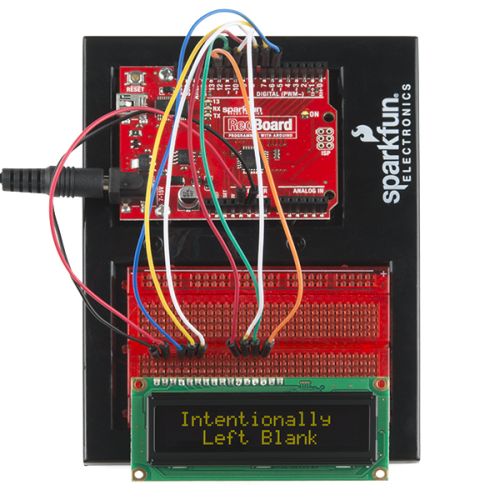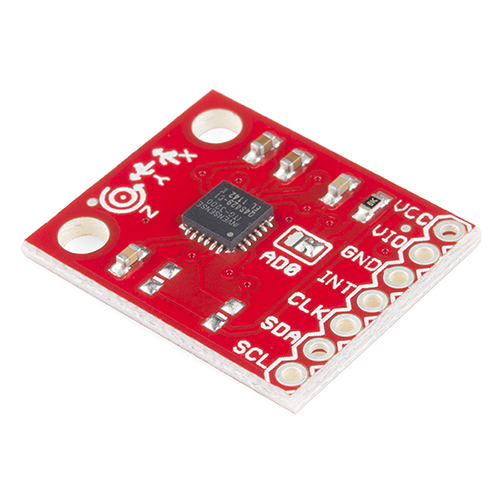Welcome back! We have a couple new products this week, as well as a demo that should have happened last week. Check it out!
ReplaceMeOpen
ReplaceMeClose
Last week LightManCA mentioned he'd like to see a demo of the RGB LED strips. Who am I to say no? That being said, if there's ANYTHING on our site you'd like to see working, ask in the comments and I'll see what I can do. Hopefully that gives everyone a better idea of how to drive the LED strips.
We already sell a lot of 16x2 character LCDs, but what if you want something a bit different? Check out the new 16x2 character OLED instead. This guy uses organic light emitting diode technology to be brighter with less power consumption. They just have a different look to them than LCD. Check out the video to see what they look like. You control them in much the same way as a traditional LCD, just with a few minor changes. Check the product page for more information.
This week we have a new revision of the ITG-3200 triple-axis gryo breakout. We've made a few minor changes to the board, and also dropped the price. You might have been seeing a lot of small revisions to older boards lately. Here's what we're doing. We're going through a lot of our old products and revamping our production techniques. This might mean new footprints, new testing or QC procedures, or minor layout or silk changes. Not only does it make it easier to produce reliably, but sometimes we get to make changes that people have been asking for. Sometimes, it makes them cheaper to produce as well. As always, feedback in the comments for products is the best way to suggest things you'd like to see.
That's all for this week. We have several products tied up in either shipping, receiving, or the final stages of documentation, so don't worry, we'll have more new products next week. Thanks for watching and reading and see you then!








Rob, nice video! Not to be too pedantic, but on the programmable LED strip, if the data flows one way, the electrons (being negative) flow the other way...
Pedantry is exhausting. Well, technically it's just tiring, or more correctly emotionally draining. But not literally.
Awww. I was just funnin' Rob, and hoping to get a Ben Franklin ref out of someone!
I had the exact same thought :-)
Step 1: Being mentioned in a new product post. Check. Step 2: Winning caption contest. Some day, my friends some day. Step 3: ???? Step 4: Profit!!
Step 3: Meet Robert, Nate, Dave, (And everyone else) in person!
Ohh that would be fun. I doubt I'd be able to swing a trip to colorado springs for a while.
I was trying to loosely quote SouthPark UnderPants gnomes: Step 1: Steal Underpants. Step 2: ???? Step 3: Profit.
Does the library for the addressable LED strips have an example which might happen to be the code you were using? Some nifty arrangement of colors you had going there!
im gonna take a guess that you were using the cerberus to power both of those arduinos at the same time. Oh and you should make a serial backpack for the OLED. or would the one you have work?
correct, I used the Cerberus for the video. We can check into a backpack if sales are good.
Now that you brought it up... someone made a promise, to do demo of those nice metal mechanum wheels, and seems that it was forgotten, well, count me as that little annoying piece of consciousness that scratches on your soul. C'mon guys, I want those, but I want one of your off-the-hook demos even more! If need ideas I'll throw few at ya right now, mechanum wheels on lunch box, that follows you around. Pleeeeease... and those addressable strips are awesome. P.S. When is next dumpster dive? =) THANKS FOR BEING AWESOME!
check the product page. We've had a demonstration video posted for a few weeks.
9 wires are required for OLED while LCD requires just few wires?
the lcd is using the serial backpack. due to the different chipset to the OLED, it won't allow them to use the current serial lcd backpack that sparkfun offers for non serial LCD's.
Since you asked, I would like to see a demo of the CAB-00064.
...mostly just because I'm curious to see what you guys can come up with to demo a 6-foot DB-25 cable and make it interesting.
um. hum. Let me think about it, no promises.
Dave! RUN!
Uh. Uh... Guys... We're cool, right guys? I mean, you're not really planning on doing what I think you're doing, right?
Guys?
Goodbye Dave
I better lay in a good supply of popcorn. This should be good! :)
Are there any tutorials on LCD's? I have been trying to get one that I had laying around for a while, but I cant seem to get it working. I have a Noritake CU20049-UW2J VFD display that I wired up to a PICAXE 40X2. Maybe the PICAXE cant handle a LCD display and I need to try an Arduino or a RedBoard; haven't seen who won the 20 RedBoards yet :(
Hey guys, I was wondering if you folks have a source for the LEDs used in LED off road light bars? They are really bright, and probably useful for other projects.
I've used the addressable LEDs from another company (something, fruit), and these things are amazingly bright. Like... if you put them on full power, and all white you can't look at them, or look towards them (and I was only using 32 lights). I bet you a couple strips of 60 would do pretty darn good!
I googled LED off road light bars and the LEDs that are used look to be just warm white high power leds, around 3W or 5W, or maybe higher. I only saw the 3W and 5W.
They have the 3W here: https://www.sparkfun.com/products/9637
With the further ventures into OLED, is there any chance e-ink* displays making a comeback in SparkFun's catalog?
( * Based on e-ink principles, not the "better readable in sunlight but still loses its display on power off" shenanigans, although the memory LCD type e-paper can be attractive..ish. )
we've been trying for a long time, but the companies just won't play ball.
Robert, you should either hire a sound engineer or learn how to mix the music properly. When doing the end of the clip, you are still talking and the music is louder than your voice. It is distracting and makes you hard to understand. The effect is that there is music and someone is making weird noises in the background.
The proper way to do this is to start the music low, you talk over it and only when you are done you fade it in fully. This requires a bit of preparation and practice from the speaker (and also an in-ear monitor), so that you finish speaking "on the beat", but the result is much better. If you are doing it by post-processing on a PC, then just be careful about the levels and proper fading, the timing can be adjusted easily.
What can I say? Sometimes I get caught up grooving to a a funky tune and the levels come out a little wonky.
I just stand in front of the camera, I don't shoot the videos. I'm sure our video guy will see this comment though.
Was that electrons flowing as a sine wave or a triangle wave?
Along the same line as the speed of the LED color change, I am not clear on if a single LED, like in the middle of the strip can be made to change while the others around it remain in their same state. I guess the question is, since the control data is actually rippling down from one end to the other, how fast is the propagation? Can you change one or 2 LEDs in the chain at a respectable rate without affecting the others? Thanks! Wonderful stuff!
You push all the data for the entire strand at once. When the refresh timeout happens (>50us delay in data), the entire strand is refreshed with the new data. If only one led's data changed, it will be the only one that changes. You certainly can change only one LED at a time. See my reply above for timing, the datasheet is quite helpful as well.
The rate at which you can change a single LED will be exactly the same as the rate at which you refresh the entire strand. Although the timing that GregFR talked about will vary depending on the length of strip you get and how many you have daisy chained together. I haven't done the math to tell you exact numbers, but if you have 10's of meters strung together, the refresh rate will be lower. (Besides requiring a hefty power supply for all those LED's!)
For the LED strip, when it was cycling through the colors at the beginning, was that as fast as the strip can be updated, or was there a programmed delay?
If you read the datasheet for WS2812, the longest a bit can be is 1.3us, so each led requires 24bits, 60 leds per meter, the longest a refresh would take would be 1872us, or 1.872milliseconds. With a 50us delay between refreshes, you could acheive in the neighborhood of at least 500 refreshes of the entire meter per second. Obviously you'l likely have more than 50us between refreshes, because you'll need to do some calculating on the microcontroller, but it can have a pretty good refresh rate.
Updated, as I misread the datasheet ;)
Thanks!